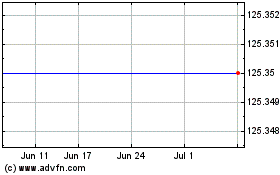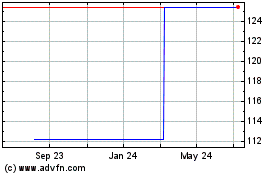Rio Tinto's New CEO Calls for It to Take More Risks
February 17 2021 - 8:04AM
Dow Jones News
By Rhiannon Hoyle
SYDNEY -- The new chief executive officer of Rio Tinto PLC wants
to change a risk-averse culture at the world's second-largest
mining company that could see it pursue commodities vital to the
energy transition more aggressively.
Jakob Stausholm said mining companies had become too cautious
after overpaying for deals around a decade ago during a rush to
feed China with metals and minerals vital to its industrialization,
which left them vulnerable to hefty asset write-downs when
commodity prices fell.
Facing an investor backlash at the time, companies including Rio
Tinto moved to prioritize dividends to shareholders and buying back
shares over deals or investments in new mines that could turn
sour.
Rio Tinto's annual result on Wednesday continued that trend. A
22% rise in net profit to $9.77 billion paved the way for a record
final dividend and a special dividend in what was Mr. Stausholm's
first earnings update since succeeding Jean-Sébastien Jacques as
CEO on Jan. 1. Mr. Jacques was ousted last year amid the fallout
from the destruction of ancient rock shelters in a remote part of
Australia.
Rio Tinto's increased profit was driven by a rally in iron-ore
prices to a nine-year high. Iron ore is used to make steel and has
been one of the hottest commodities as China bets on
infrastructure, such as new highways and apartment construction, to
drive its economic recovery from the coronavirus pandemic.
In an interview with The Wall Street Journal, Mr. Stausholm said
Rio Tinto needs to broaden the commodities it digs up if it is to
play a role in the world's transition away from fossil fuels to
cleaner alternatives such as batteries, electric vehicles and
renewable power. The company should also aspire to produce more
copper and aluminum, used in low-carbon technologies.
"We should pursue those," said Mr. Stausholm, adding the company
needed to regain a mind-set that put an emphasis on growth. "I need
to see people daring to raise their hands and saying, 'I believe in
this.' We are probably a bit too risk averse, so that is something
we need to build internally."
The strategy may not lead to a return to big deals. Mr.
Stausholm suggested Rio Tinto is more likely to focus on developing
its own mines. They include the Winu copper deposit in Australia,
which it hopes will begin production in 2024, copper projects in
the U.S. and Mongolia, and a large lithium deposit in Serbia. Rio
Tinto is also advancing a big African iron-ore development as well
as new projects in Australia that will replace the tons it digs out
of the ground.
"We need to double down on our capability to develop," said Mr.
Stausholm, formerly Rio Tinto's chief financial officer. "I really
want to see us unleashing all of our energy in this."
Analysts think it is a necessary shift. Investment bank
Jefferies said Rio Tinto, along with rival BHP Group Ltd., will
move to focus more on growth over the next 1-2 years.
"Rio and BHP are yield plays for now, and this works in a world
of ultralow interest rates," said Jefferies. "The question is: Will
it continue to work in a strong global growth environment with
steepening yield curves?"
Rio Tinto's reputation was badly damaged by last year's
destruction of the caves at Juukan Gorge in Australia, which
contained a trove of artifacts that indicated they had been
occupied by humans more than 46,000 years ago. Investors were
unhappy with the company's initial response, and pushed for greater
accountability, which led to Mr. Jacques and two other executives
losing their jobs.
Mr. Stausholm said Rio Tinto's social license -- community
support for its activities -- would be one of four overarching
goals under his stewardship. The others are sharper operational
skills, development capability and a stronger focus on
environmental, social and governance issues.
While Mr. Stausholm will work with his new executive team on a
strategic plan that would likely be ready in the final three months
of 2021, he said it won't mark a radical shift. "I was the CFO the
previous two years, and I have certainly bought into a lot around
the strategy," he said.
An early move has involved setting a target on so-called Scope 3
emissions, pollution mostly created when customers transport and
use the commodities Rio Tinto produces.
Pressure has been building on mining companies to work harder
with their customers to curb carbon emissions. Rio Tinto's iron ore
is a key ingredient in the making of steel, a heavily polluting
industry.
Still, the company remains vulnerable to missteps. When changing
his top ranks last month, Mr. Stausholm chose an executive seasoned
in China relations, Simon Trott, to lead Rio Tinto's important and
very profitable iron-ore business. The reshuffle wasn't
communicated beforehand to the traditional owners of the Juukan
Gorge, the Puutu Kunti Kurrama and Pinikura people, or PKKP, who
felt it was another sign of disrespect.
The PKKP and Rio Tinto later said they would continue to work on
repairing ties.
"Of course, it demonstrated that our rebuild of the relationship
is still young and fragile," Mr. Stausholm said.
Write to Rhiannon Hoyle at rhiannon.hoyle@wsj.com
(END) Dow Jones Newswires
February 17, 2021 07:49 ET (12:49 GMT)
Copyright (c) 2021 Dow Jones & Company, Inc.
Rio Tinto (ASX:RIOCD)
Historical Stock Chart
From Mar 2024 to Apr 2024

Rio Tinto (ASX:RIOCD)
Historical Stock Chart
From Apr 2023 to Apr 2024
